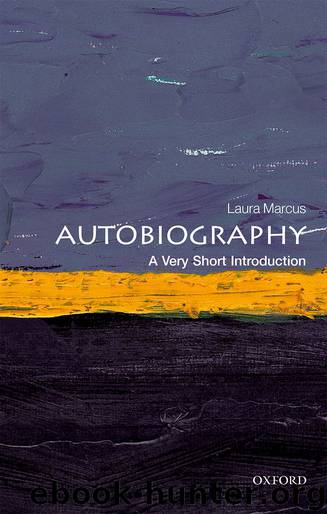Autobiography by Laura Marcus

Author:Laura Marcus
Language: eng
Format: epub
ISBN: 9780191647055
Publisher: OUP Oxford
Published: 2018-05-07T16:00:00+00:00
The most popular picture round our way—every family had one—usually above a three-bar fire—was a commercial painting called The Weeping Boy. There were several versions of it, but they all showed a child in distress. I believe it helped us to visualise our self-pity, and to accept a certain amount of kitsch. I spent hours looking at that picture, thinking it odd, thinking it mawkish, but feeling it must be social realism.
The category of the ‘misery memoir’, sometimes known as ‘pathography’, indicates both the commercial structures of publishing which have promoted the literature of ‘the imperfect childhood’ and a certain contempt for, and perhaps exhaustion with, such writing. The category of ‘misery literature’ seems to have first been used to describe the American writer Dave Pelzer’s memoirs of his abusive childhood with an alcoholic mother; these, in particular the first, A Child Called ‘It’, remained bestsellers for a number of years. Pelzer’s writing brings together graphic accounts of intense childhood suffering with an insistence that such a past can be survived; in addition to his autobiographies, Pelzer has written a number of works of self-help and life-coaching.
The ‘misery memoir’ is, however, too broad and generalized a label to do justice to the range of autobiographical works, and ways of writing, that might conceivably fall within its purview. Frank McCourt’s Angela’s Ashes, an autobiographical account of an impoverished childhood, first in New York and then in Ireland, was also a major commercial success, but it takes an ironic distance from ‘pathography’. As McCourt writes: ‘When I look back on my childhood I wonder how I survived at all. It was, of course, a miserable childhood: the happy childhood is hardly worth your while. Worse than the ordinary miserable childhood is the miserable Irish childhood, and worse yet is the miserable Irish Catholic childhood.’ Andrea Ashworth’s Once in a House on Fire tells, in prose at once harsh and lyrical, the story of a childhood spent under the domination of two ‘unfathomably violent’ stepfathers. Her survival and escape, too, come through books and through her own words: ‘I could put poetry into clouds and gutters and all kinds of filth. I could turn nasty things at home into stories.’
Jeanette Winterson’s memoir, Why Be Happy When You Could Be Normal?, returns to many of the persons and scenes described in her semi-autobiographical first novel Oranges Are Not the Only Fruit, in which she gave a vivid account of an eccentric childhood. Her narrator is, like Winterson herself, the adopted daughter of working-class Pentecostal parents in the North of England; the extraordinary, terrifying mother is the force from which she must escape. More than two decades later, Winterson writes in the memoir that Oranges—‘faithful and invented, accurate and misremembered, shuffled in time’—was a ‘cover version’ of her childhood experiences: ‘I wrote a story I could live with. The other one was too painful. I could not survive it.’ She uses the language of trauma, while suggesting that the ‘wound’ is closely allied to the ‘gift’: ‘All my life I have worked from the wound.
Download
This site does not store any files on its server. We only index and link to content provided by other sites. Please contact the content providers to delete copyright contents if any and email us, we'll remove relevant links or contents immediately.
The Hite Report on Shere Hite by Shere Hite(1992)
The One Percenter Encyclopedia by Bill Hayes(1754)
Benjamin Franklin: An American Life by Walter Isaacson(1683)
Benjamin Franklin : an American Life by Walter Isaacson(1397)
God Is Not Great by Christopher Hitchens(1243)
Book of Obituaries by Ann Wroe(1234)
Who's Who in the Age of Jesus by Geza Vermes(1170)
On Sparta (Penguin Classics) by Plutarch(1135)
A Treasury of Royal Scandals by Michael Farquhar(1062)
Bloodletters and Badmen by Jay Robert Nash(1047)
Agatha Christie Murder in the Making by Agatha Christie & John Curran(1045)
Heroes by Paul Johnson(1000)
The Fortunate Pilgrim by Mario Puzo(980)
A Dictionary of Political Biography by A Dictionary of Political Biography(967)
Men in Dark Times by Hannah Arendt(950)
Stepping Stones by Dennis O'Driscoll(904)
The Motion of Light in Water: Sex and Science Fiction Writing in the East Village by Delany Samuel R(895)
Agatha Christie's Secret Notebooks by Agatha Christie & John Curran(889)
Devil May Care by Unknown(887)
